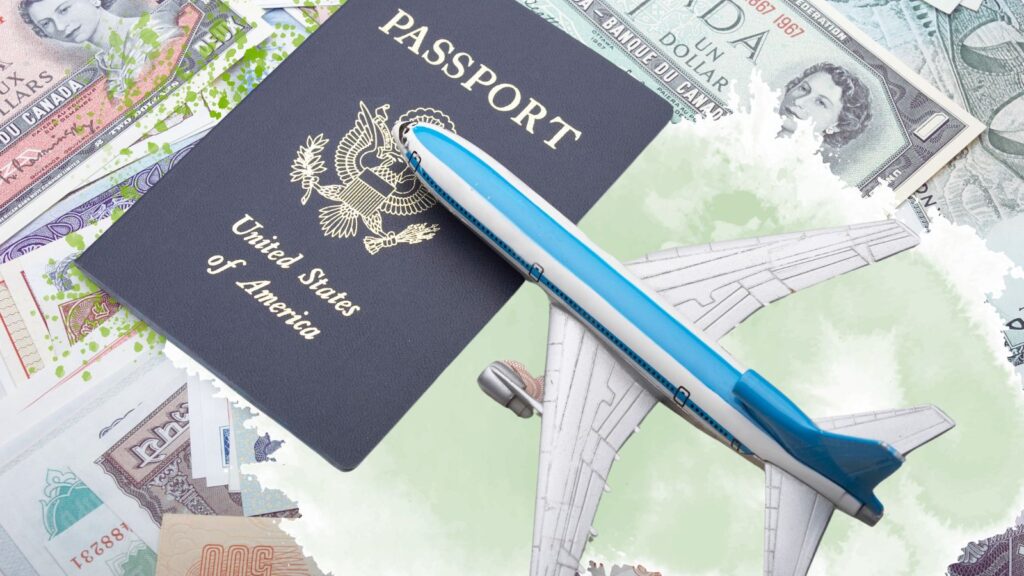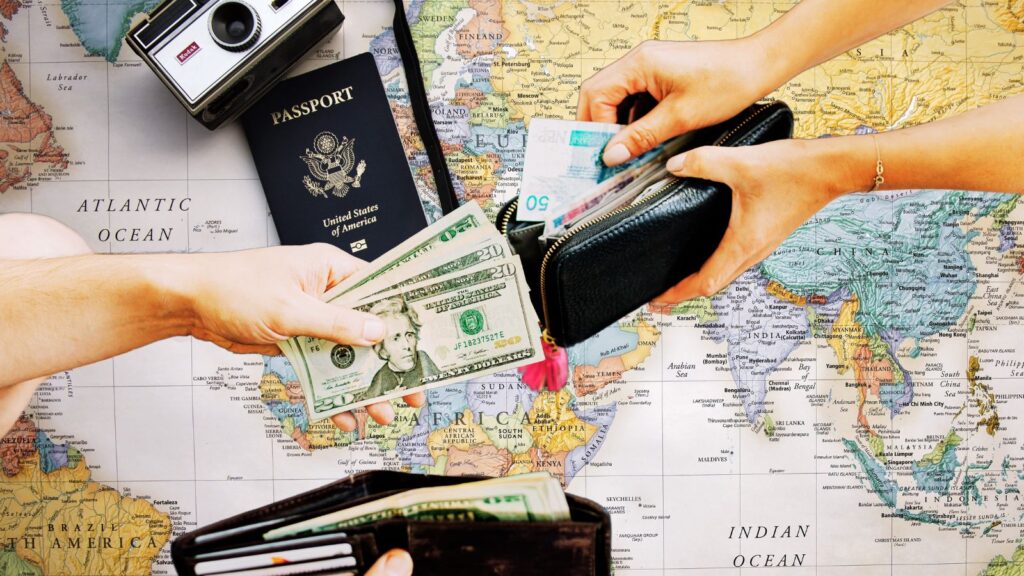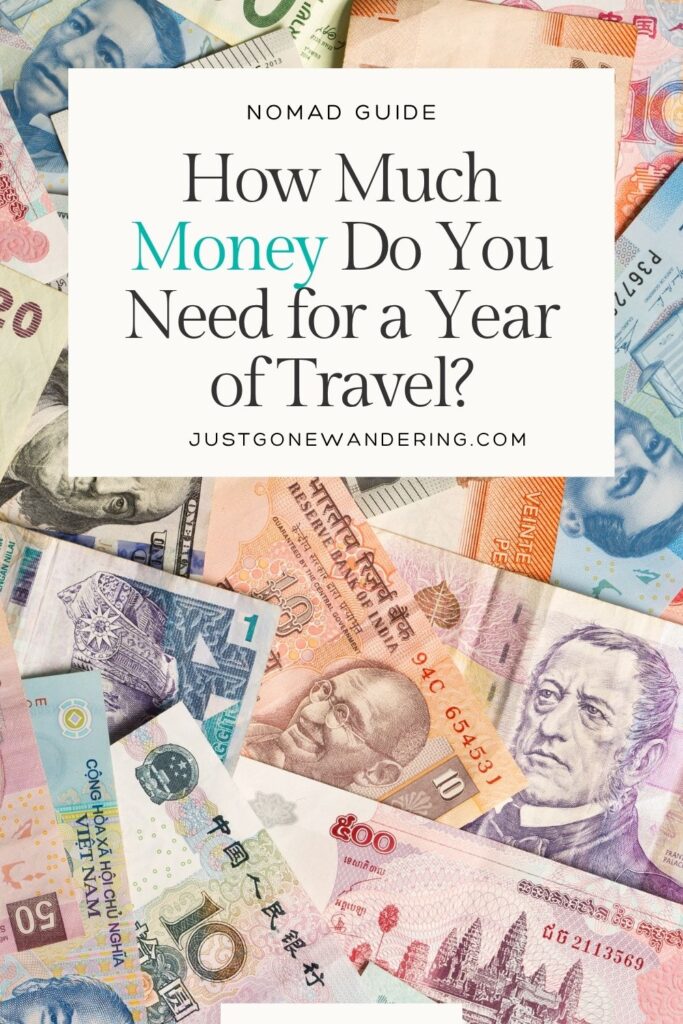How Much Money Do You Need to Travel the World?
This is a popular question with wannabe nomads, and unfortunately it’s also the kind of question that can’t be easily answered.
Why? Well, everyone has different comfort levels, basically, as well as different travel goals and dreams. All that informs the amount of money you’ll need to be a full-time traveler.
Think about it: if you want to travel the world in style, staying at luxury resorts and flying first-class everywhere, then your budget will be massively different from someone who plans to couchsurf, hitchhike and camp.
But to be honest, I think most people just want to know how cheaply they can travel the world full-time, how much they need to have in savings and how they can fund their travel lifestyle while on the road. So I’m here to answer those questions, as a full-time traveler myself for over 3 years now.
If you’re interested in seeing how much I spend as a full-time cozy budget traveler, I have two blog posts with detailed budget breakdowns: my 2023 travel budget was $18,340 USD and my 2024 travel budget total was $14,620 USD. In 2025, I’m on track to spending less than $10,000 USD– because I started housesitting!
If that’s inspiring you, then keep reading to figure out YOUR (potential) travel budget.
Just Gone Wandering is supported by readers! This post contains affiliate links. If you click on a link and buy something, I get a small percentage at no extra cost to you. Your support helps keep this blog running— thank you! Read full disclosure here.
Figure yourself out first
Before you can do anything, you need to know what kind of traveler you are, and if you’re willing to actually do all the budget-saving stuff that people talk about.
It’s all well and good to say you’ll sleep in $3 hostels and eat cucumbers for dinner every day, but actually LIVING that lifestyle for months on end is VERY different. Especially if you aren’t used to living on a budget in your home location!
So ask yourself this:
What kind of traveler are you?
Really give this a deep think. It’s the base for your entire budget, and it’ll be entirely personal to you.
When you go on trips now, do you spend everything you have and go to fancy restaurants and high-end hotels? Do you have expensive hobbies, like scuba diving or snowboarding, that you’ll want to continue doing on the road? Are you able to pack with a carry-on only, or are you a consistent overpacker with a massive suitcase?
Are you comfortable staying in shared accommodations, like hostels? Are you willing to take a $10 bus over a $50 flight, even if it takes you 10 hours more to get somewhere? Are you willing to cook most of your own meals, or at the very least eat only local food and not expensive imported stuff?
There’s no shame in preferring one way over another. If you’re more comfortable in apartments and having a private driver, then that’s what you’re probably more happy doing in your nomad life. You’ll just have to adjust your spending expectations to match that– you won’t be on a backpacker’s budget.
Myself, I’m a mix of super budget and mild luxury. I call myself a cozy budget traveler because I don’t mind sharing a room in a hostel or taking the bus, but I’ll spend a bit more to upgrade to a nicer dorm or a more comfortable seat. I also spend more time in lower cost-of-living areas, and I’ve started doing housesitting to save on accommodation costs. My average spend for the last 3 years of full-time travel is about $38/day, which isn’t too bad!
What do you want to experience/see when you travel?
Most people start off their nomad life with a huge list of must-see places, and I’m no different. I still have a list of things I want to see and places I want to go, but it’s tempered by my budget and my slow travel lifestyle. In fact, it’s sometimes difficult to make myself go see things, because I keep thinking I can always come back and see them later!
If you only plan to travel for a year or two, then you’re going to want to cram as much as possible into your trip (understandable)– just know that this will increase your overall budget because you’ll be spending more on transit costs and entrance fees, especially compared to your “home” life. Paying a $20 museum entrance once or twice a year isn’t a big deal, but when you’re paying that multiple times every week it can add up fast!

Quick tip: make a list of your top 10 things you want to see, and then go to their official websites to get their entrance price(s). That’ll give you a good idea of how much you’ll need for tourism purposes.
On the other hand, if you want to travel indefinitely, then eventually the oncoming pressure of time starts to lessen, so you feel less like you have to rush form place to place. And you may not even be interested in visiting some of the major tourists sites after all, when so many of them have unfortunately turned into tourist traps.
Keep in mind too that the major tourist destinations even in “cheap” countries tend to be somewhat on the higher-priced side of things ($50+), especially if there’s a lot of Western tourists coming in. You’re also going to pay more for surrounding amenities like hostels/hotels, transport to/from the thing, and even guides. You can save a lot of money by going instead to offbeat (usually free) locations, even in major tourist cities.
If you’re interested in learning how to plan a route for the year, check out my guide here.

Where do you want to go?
It’s more expensive to travel in countries that cost more (duh). That includes most of Western Europe, the US/Canada, and even places like Africa can be more expensive in certain ways (transportation, visas and tourist activities). Southeast Asia is famous for being a budget-friendly place to travel, and Central Asia/Eastern Europe isn’t too bad, either.
If you mostly want to spend time in more expensive places, then obviously your budget will be higher. If you want to spend less, you’ll have to travel in lower-cost areas. That’s why many full-time travelers hang out in Southeast Asia (and South America) so much!
Here’s an example of the pricing for hostels in two regions popular with travelers:
In Western Europe, like England, France, Spain: average night in a shared dorm is about $50 USD (no breakfast)
In Southeast Asia, like Malaysia, Vietnam, and Laos: average night in a shared dorm is about $10 USD (with breakfast!)
Major price difference! One night in France is worth 5 nights in Laos– but of course, if most of the things you want to see are in France, then that’s where your budget is going to go, so you’ll have to plan accordingly.
🌟Tip: Check Hostelworld for average hostel prices in a few places you’re interested in visiting. Pick one or two highly-rated places and use their price points as an estimate for your monthly accommodation budget.
How comfortable are you with being inconvenienced?
Many of life’s little inconveniences can be fixed by throwing money at it, even for things like visa applications or getting across the border.
And to be honest, most people would rather spend $100 on a plane ticket than $10 on a bus ticket, because they don’t want to be inconvenienced by long travel days (like being on a bus for 12+ hours). They’d also rather eat out every meal, or splurge on a guided tour.
But if you really want to make your budget stretch, you have to be willing to be inconvenienced once in a while. You have to take the $10 bus, cook your own food and make do with an audio guide/pamphlet.
If you’ve never traveled on a budget before, then you have a lot more adjusting to do! But it can be done– and if you treat it more like a money-saving challenge and less like you’re depriving yourself of something, then you’ll have a lot more fun.

Tip: Use resources like Rome2Rio and 12Go to get prices for long-distance buses/trains between major cities, and use that to estimate your overland travel costs. Skyscanner is a good resource for finding flight prices!
How good are you at keeping to a budget?
This ties back to the “how okay are you at being inconvenienced” question– if you’ve never traveled on a strict budget, or if you’re generally just bad at being on a budget, then you’re not suddenly going to be great at it when you start traveling full time. It does take practice to travel on a budget!
For myself, I’m generally okay with not spending on big purchases (like expensive tours) but I get sucked into spending a lot of little ones. Like, when I’m in Southeast Asia I have a bad habit of ordering Grab food delivery nearly every day, because it’s so convenient! But even spending $10-20/day on food delivery adds up after a while, so I really have to be strict with myself.
That’s partly why my budget got smaller and smaller over the years, because I got better at reigning my spending in. I recommend giving yourself a little buffer when you start out, and see where you’re spending the most money so you can adjust in year two.
🌟Tip: Keep track of your spending with a spreadsheet!
Can you handle unexpected expenses?
Stuff like having to buy a new visa, or a new plane ticket somewhere. Even medical expenses can add up, as you need to pay for them before your insurance reimburses you. You’ll need a portion of your budget set aside for the unexpected, just in case.

Will you work and travel, or live off savings?
Quit your job and travel the world!
This is what people dream of doing. Usually that also means they aren’t working while traveling, so they’re living entirely off their savings. That’s what I did my first two years of traveling full-time, and though it took me 10 years to actually save all that money, having a large savings meant I could focus on enjoying my trip without worrying about work.
Now I work and travel, and while it’s still enjoyable, it’s a very different experience than just pure “travel life”. I’m more focused on finding places I can stay for a month or more, and I’m doing a lot less sightseeing and tourist activities. (See other downsides of digital nomad life here.)
The longer you travel, the more money you’ll need. Either that means having a large savings account you can dip into, or it means MAKING money while on the road. There’s no way around it!
Here’s some ideas for a remote job, or if you prefer you can get an in-person travel job (many of which provide free accommodation!) and travel during the off-season. I’ve also met people teaching in international schools and traveling during the holidays!
Okay but for real, how much do I need?
Yeah, okay, here you go:
I recommend AT LEAST $1,000 USD/month or $12,000/year for a full-time travel budget.
That’s the minimum, in my opinion. $1,000/month is enough to travel on a tight budget, where you’ll be staying in hostels mostly but still have enough money for tourist activities, a bus to the next city, and the occasional imported food treat from home.
You WILL have to stick to lower cost areas, and/or do work exchanges in more expensive cities to cut down on accommodation costs. You’ll be taking a lot of overland transit, and you’ll probably be cooking at home more often than not. It’s a different kind of travel lifestyle from what you see on Youtube and TikTok (you probably won’t be out partying all night if you’re working in a hostel the next day) but it’s still very rewarding and fun, and you’ll have a lot more interesting stories when you return home.
If you want to stay in your own apartment, go on some day tours and maybe drinks with friends (aka the cozy budget traveler life), then I recommend at least $1,200-1,5000/month. That’s what I was doing in 2024, and my average spend per month was $1,204 USD.
To compare it to another year (2023) where I was moving more quickly between locations and doing a lot more expensive things, including a multi-day motorcycle tour, my average was $1,495/month. Ironically, slowing down let me save more money, because I could get monthly stay discounts. It worked out to be even cheaper than a private room in a hostel!
Whatever your budget, I recommend keeping at least $1,500 in an emergency fund, separate from your travel fund. This is enough to get you a plane ticket home, a new passport, a new phone, etc. if something happens and you’re in an emergency situation.

What if you don’t have a lot of money saved?
You can still travel! But it’ll be different (and harder) than if you have a decent amount saved already.
You’ll need to do stuff like work exchanges where you trade your time and effort for a place to stay.
And you’ll need to stick to less costly locations, like Southeast Asia.
Plus, most importantly: you’ll have to get used to sharing spaces with strangers, like staying in backpacker hostels and taking public transportation everywhere. (This can be icky for some people, but it’s really the only way to travel on a tight budget.)
Most of all, you’ll need to travel slowly, so you aren’t blowing your budget on plane tickets all the time. Spend as much time as you can within a country, meet people and explore the neighborhood– it’s a wonderful way to travel, in my opinion.
Final Thoughts
Basically the most important thing is to be realistic about your travel style and how it affects your budget. If you’re not used to traveling on a restricted budget, it’ll take you a little bit to adjust to your new reality. Or else you’ll need a much larger savings account!
The other thing to keep in mind is that everyone has different budgets and different comfort levels. You’ll often see people saying they traveled the world for a crazy low amount of money, but then you find out that was 20 years ago and prices have tripled since then. Likewise you’ll see luxury travelers on Youtube and Instagram!
Instead, check for prices yourself by asking on travelers groups for current costs, or by reading budget breakdowns from travel bloggers (like me!). Pretend you’re booking a month-long trip somewhere and see how much it’d cost, and use that as a basis for a year+ budget.
Good luck, and happy travels!
Save to Pinterest



Best Travel Resources
- 👩💻Stay organized with the Deluxe Travel Planner Spreadsheet
- 🛌Search Hostelworld for budget stays
- ✈️Search SkyScanner for discounted flights around the world
- 😺Join TrustedHousesitters and do petsitting in exchange for accommodation
- 💳Carry Chase Sapphire Preferred for a travel-friendly credit card
- 📱Use Airalo for eSIMs around the world
- 🚙Check DiscoverCars for international car rentals
- 👩💻Snag ExpressVPN to stay safe while browsing the web
- 🧑⚕️Sign up with VisitorsCoverage for trip insurance







